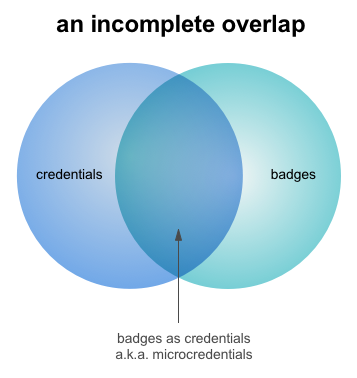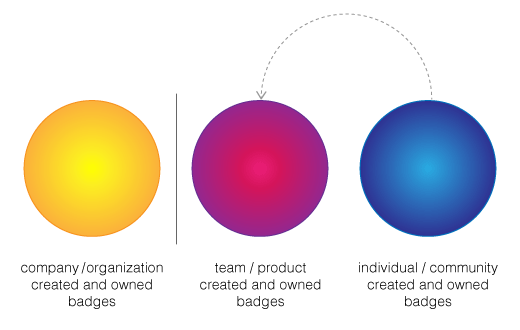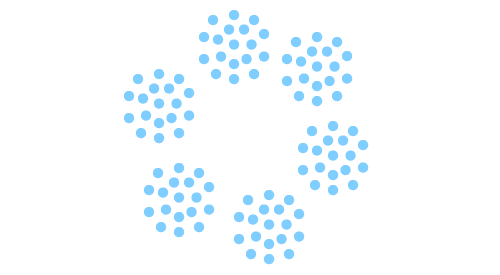As an individual who has been helping to build Open Badges from their start, I often find myself in awe of the ecosystem’s dynamism and growth. I also periodically find myself in awe of how little public understanding exists with regards to many aspects of them. This post is part of my ongoing effort to provide historical background and conceptual context to the genesis of this amazing open badges movement.
I am happy to note that a portion of the growth and success of the open badges community, perhaps a very healthy portion, has come from an intentionally laissez-faire attitude toward the building of the open badge infrastructure (OBI). An open attitude that encouraged experimentation over control, and that resulted in a variety of different and vibrant approaches to open badges.
Assertion: a more controlled, top-down, prescriptive approach would not have allowed the open badges ecosystem to grow in the beneficial ways that it has, nor would we have achieved the success and adoption that we have enjoyed thus far.
At its origin, the OBI represented a proposed structure for how a fully developed open badges ecosystem might work. Even now, the growth of the Open Badges movement still depends upon a primary evolutionary conceptual ideal linked to a series of technical specifications. Open badges has been planned as a true ecosystem, and unlike Athena, it does not spring forth fully formed from anyone’s head. Instead its functioning parts emerge and combine bit by bit.
Consequently, the fact that not all of the originally-imagined and -proposed world has developed into actual tools in unsurprising. And not every tool that has been developed has been well documented or even fully explained at launch—which occasionally left the community at large to figure out what something was and how it might be or should be used.
Assertion: This is the outcome of a small group of people hurrying to effect change quickly; regardless of good intentions, some things simply get left behind in the rush to build, structure, and elevate. It’s the unfortunate Mr. Hyde side of the moving-fast-and-breaking-things Dr. Jekyll approach.
So much ink has been spilled already on the subject of the Mozilla badge backpack: almost from the start it has been both an important philosophical stake in the ground about personal data ownership as well as a raging battleground about its necessity. Questions about it have abounded. What works, what doesn’t. Who uses it, who doesn’t. What’s happening with it, what has happened to it. And yet, even with all of this back and forth, there has always been so much more to say about it. So here goes.
The Mozilla open badges backpack was one of the primary structural concepts of the OBI. And it was one of the ideas that ultimately manifested as a real tool. And what a complicated life it has led. So many high hopes for it and so many challenges to it. Unfortunately, the documentation of its initial conceptualization has never quite fully materialized and so the public understanding of it remains fuzzy.
Assertion: Not an excuse but a reality: in the small team development of open standards software, some areas receive more love (read: attention, money, time) than others. Some tools get a great deal of positive attention. Others languish in a benevolent neglect sort of way.
If a tool’s uptake is not satisfactory, it can be abandoned, i.e., no longer supported by the originating/sponsoring organization. In other words, it gets downshifted to maintenance, or to the even lower gear of community development. (An aside: There are a number of really intriguing Mozilla tools that have followed this trajectory, e.g., Thunderbird, Sunbird, and Persona. That last one is pretty significant in that it was a key aspect of the development of the backpack.) Over time the Mozilla Open Badges Backpack has drifted into one of the lesser support categories.
But before we start singing dirges for the backpack, let’s examine its promising early history. Its original intent was as a referatory for open badges—any and all open badges from any and all issuers. Just fyi: the decision to create a referatory was based on the underlying structure of the open badge.
But let’s be even more precise: the Mozilla Open Badges Backpack was created as a reference implementation of how a badge backpack could work. It was designed to be completely agnostic with regards to where an open badge had been issued and by whom.
Assertion: With the backpack, the open badges initiative further enshrined interoperability as a key aspect of the open badges ecosystem.
The backpack, as originally designed, was also an opportunity to express creativity and personal agency. Its structure allowed earners to make decisions about what badges should be public vs. private, what badges might be linked together to create even more relevant connections, and what badges had greater social or personal relevance. It acted as an accretive, personal diary of achievements, experiences, and relationships.
Assertion: By providing a way for an earner to gather their badges together in one place, group them as they saw fit, and share them with whomever they deemed worthy, the backpack took deadly aim at existing and future learning silos.
One of the best unheralded benefits? When a badge earner used the reference implementation of the Mozilla Open Badges backpack, there was no requirement for them to be a member of a separate, corporate-owned social network in order to display their badges. Not at all.
Because in its original implementation, the backpack had the concept of equity baked into it. And yes, I buried the lede all the way down here.
Conclusion: The Open Badges backpack was structured around the concept of equity, personal data ownership, and interoperability. It discouraged siloing of learning recognition and encouraged personal agency.
With all of this historical reference information now clearly articulated, your opinion of what the Mozilla open badges backpack was and what it might be is more informed. Although the discussion about the backpack has waned over time—some individuals call for it to be eliminated altogether, some still want it to survive—in either case, this background information serves to foreground the significantly thoughtful consideration that went into the original construct of the open badges ecosystem.
Stay tuned for more historically-informed discussions of conceptual and philosophical basis for the open badges ecosystem.




















